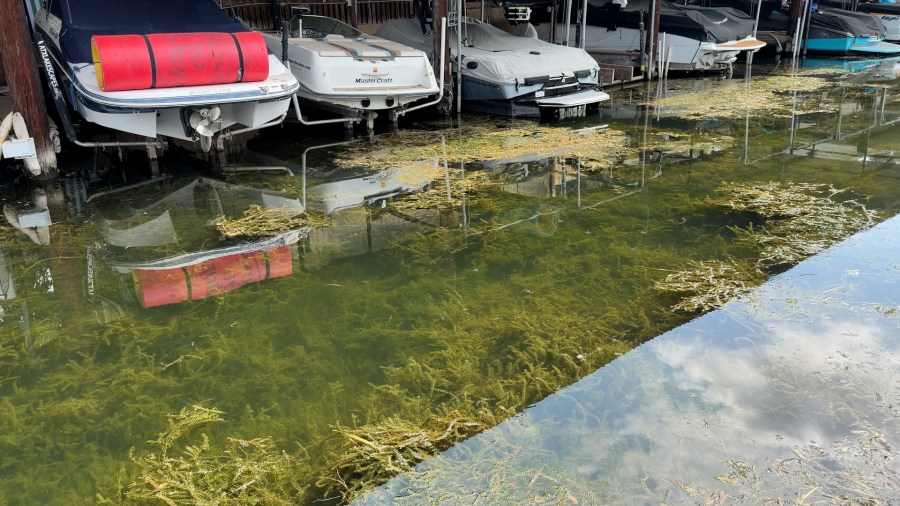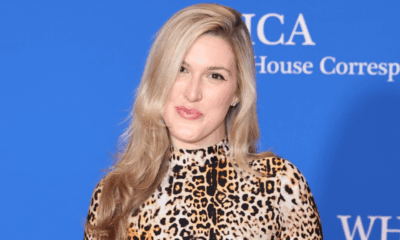Science
Lake Austin Business Owners Urge City to Drain Lake to Combat Hydrilla

Business owners around Lake Austin are advocating for the city to initiate a drawdown of the lake to combat the resurgence of the invasive plant, hydrilla. This plant, which can obstruct boat motors and create hazardous swimming conditions, has proliferated significantly in recent months, leading to concerns among local residents and business operators.
Hydrilla has re-emerged in Lake Austin, with dense patches of the plant now covering extensive areas downstream from the Tom Miller Dam. Eric Moreland, the owner of Moreland Properties and a member of the advocacy group Friends of Lake Austin, noted, “We have stories of jet skis getting caught in the hydrilla.” For over thirty years, this group has worked to mitigate the impact of hydrilla, which can entangle swimmers and obstruct docks.
In June 2023, a city survey revealed that only 5% of Lake Austin was affected by hydrilla. To manage the situation, the city introduced approximately 300 sterile grass carp into the lake, a species known for feeding on hydrilla. Despite these efforts, Moreland reported that the problem worsened over the summer. Following heavy rains from the July 4th floods, sediment and debris entered the lake, creating conditions that allowed hydrilla to spread rapidly.
After observing the extent of the hydrilla’s spread, the Friends of Lake Austin commissioned an independent biologist to conduct a survey. This assessment indicated that the invasive plant now occupied 38% of the lake. The city subsequently undertook another survey, corroborating these findings.
The history of hydrilla in Lake Austin is a troubling one. In the late 1990s, less than 5% of the lake was covered by the plant. By 2012, that figure had skyrocketed to nearly 40%. In response, the city began stocking the lake with sterile grass carp, reaching populations of 35,000 by 2014. While the carp helped eliminate hydrilla, they also consumed other aquatic plants, ultimately leaving Lake Austin devoid of vegetation from 2016 to 2023.
Local anglers like Ryan Zolper express concern about the ecological balance in the lake. Zolper, an avid bass fisherman, emphasized the importance of hydrilla as a habitat and food source for fish. “I care a lot about protecting the bass fishery. It’s a big hobby for me, huge industry in the area and the country as well,” he stated.
In response to the latest hydrilla assessments, the city plans to increase the number of grass carp to approximately 1,900, aiming for a stocking rate of five fish per acre. Moreland described this approach as insufficient, stating, “It’s more of a maintenance level. It’s really not going to do much.” He and his colleagues are advocating for a proactive solution, specifically a drawdown of Lake Austin to facilitate the removal of hydrilla.
Moreland called on the city to request the Lower Colorado River Authority (LCRA) to initiate a drawdown in January. The LCRA oversees the management of the Highland Lakes, including Lake Austin and Lake Travis. He believes that reducing the lake’s water levels would help eliminate hydrilla and allow homeowners to perform necessary maintenance.
Historically, the lake has undergone drawdowns, with the last occurring nine years ago. During a virtual town hall on October 16, Moreland presented data from Texas Parks and Wildlife, indicating that previous drawdowns, combined with the introduction of grass carp, successfully reduced hydrilla populations. However, city officials presented contrary data, suggesting that some drawdowns had failed to curb hydrilla growth and, in some cases, led to an increase in its prevalence.
Moreland is hopeful that the city will pursue the drawdown sooner rather than later, allowing residents to prepare for the changes. “We want to be proactive versus reactive,” he concluded, emphasizing the need for swift action to protect the lake’s ecosystem and ensure a healthy environment for future generations.
-

 World5 days ago
World5 days agoExposing the Reality Behind Guatemala’s Garment Industry
-

 Politics5 days ago
Politics5 days agoLB Pharmaceuticals Quiet Period Ends October 21, Analysts Weigh In
-

 Business5 days ago
Business5 days agoRoyal Bank of Canada Upgrades Ovintiv to Outperform Rating
-

 Sports5 days ago
Sports5 days agoSaquon Barkley Reflects on James Franklin’s Dismissal from Penn State
-

 World5 days ago
World5 days agoHamas to Return Remains of Additional Hostage on Friday
-

 Health5 days ago
Health5 days agoFDA Announces First Nine Recipients of National Priority Vouchers
-

 Science5 days ago
Science5 days agoMIT Develops 3D Brain Models from Patient Cells for Custom Therapies
-

 Entertainment5 days ago
Entertainment5 days agoOlivia Nuzzi’s Memoir Set to Uncover RFK Jr.’s Controversial Texts
-

 Lifestyle3 days ago
Lifestyle3 days agoHistorian Seeks Help to Uncover Cherry Street’s Past
-

 Science3 days ago
Science3 days agoYale School of the Environment Launches Accelerated Master’s Programs
-

 Entertainment5 days ago
Entertainment5 days agoSylvester Stallone’s ‘Alarum’ Surges in Streaming Despite Poor Reviews
-

 Lifestyle5 days ago
Lifestyle5 days agoSouth Los Angeles Intersection Renamed to Honor Activist Danny Bakewell Sr.









